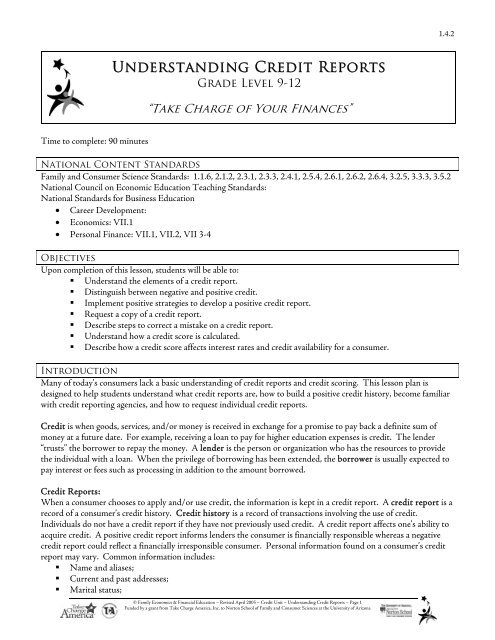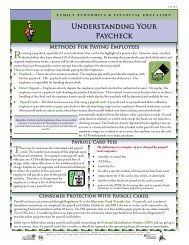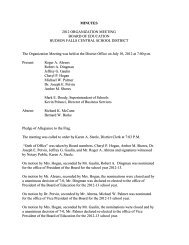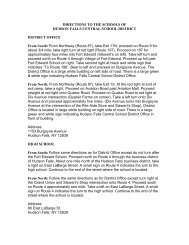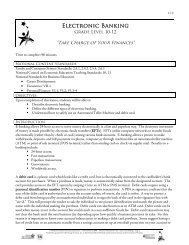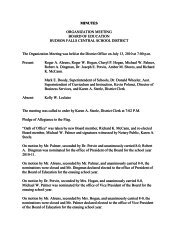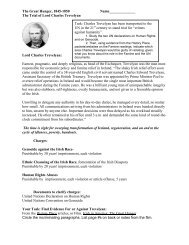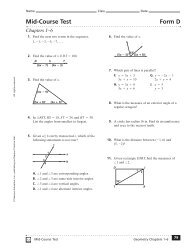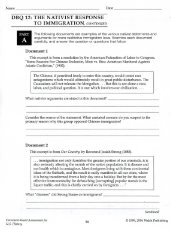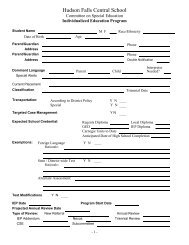Create successful ePaper yourself
Turn your PDF publications into a flip-book with our unique Google optimized e-Paper software.
1.4.2<strong>Understanding</strong> <strong>Credit</strong> <strong>Reports</strong>Grade Level 9-12“Take Charge of Your Finances”Time to complete: 90 minutesNational Content StandardsFamily and Consumer Science Standards: 1.1.6, 2.1.2, 2.3.1, 2.3.3, 2.4.1, 2.5.4, 2.6.1, 2.6.2, 2.6.4, 3.2.5, 3.3.3, 3.5.2National Council on Economic Education Teaching Standards:National Standards for Business Education• Career Development:• Economics: VII.1• Personal Finance: VII.1, VII.2, VII 3-4ObjectivesUpon completion of this lesson, students will be able to:• Understand the elements of a credit report.• Distinguish between negative and positive credit.• Implement positive strategies to develop a positive credit report.• Request a copy of a credit report.• Describe steps to correct a mistake on a credit report.• Understand how a credit score is calculated.• Describe how a credit score affects interest rates and credit availability for a consumer.IntroductionMany of today’s consumers lack a basic understanding of credit reports and credit scoring. This lesson plan isdesigned to help students understand what credit reports are, how to build a positive credit history, become familiarwith credit reporting agencies, and how to request individual credit reports.<strong>Credit</strong> is when goods, services, and/or money is received in exchange for a promise to pay back a definite sum ofmoney at a future date. For example, receiving a loan to pay for higher education expenses is credit. The lender“trusts” the borrower to repay the money. A lender is the person or organization who has the resources to providethe individual with a loan. When the privilege of borrowing has been extended, the borrower is usually expected topay interest or fees such as processing in addition to the amount borrowed.<strong>Credit</strong> <strong>Reports</strong>:When a consumer chooses to apply and/or use credit, the information is kept in a credit report. A credit report is arecord of a consumer’s credit history. <strong>Credit</strong> history is a record of transactions involving the use of credit.Individuals do not have a credit report if they have not previously used credit. A credit report affects one’s ability toacquire credit. A positive credit report informs lenders the consumer is financially responsible whereas a negativecredit report could reflect a financially irresponsible consumer. Personal information found on a consumer’s creditreport may vary. Common information includes:• Name and aliases;• Current and past addresses;• Marital status;© Family Economics & Financial Education – Revised April 2005 – <strong>Credit</strong> Unit – <strong>Understanding</strong> <strong>Credit</strong> <strong>Reports</strong> – Page 1Funded by a grant from Take Charge America, Inc. to Norton School of Family and Consumer Sciences at the University of Arizona
1.4.2• Date of birth;• Employment history;• Public record;o Judgments, criminal, and bankruptcy• Payment history;o <strong>Credit</strong> cards, store cards, book clubs, music clubs, etc.• Financial records;o Loans, past and current accounts, bounced checks, miscellaneous fees, etc.• Loans/leases;o Rent-to-own contracts, payday loans, lease agreements, etc.• Number of credit inquires.o <strong>Credit</strong> inquiry – a request for your credit. These inquiries are done by businesses you apply to forcredit as well as businesses that you do not contact, but whompre-approve you for credit.*Medical information is not allowed on a consumer’s credit report, but late medical payments are.Building <strong>Credit</strong> History:Building a credit history is important for consumers planning on purchasing big ticket items, such as a house, oncredit. Generally, people have to establish a credit history before they purchase those big ticket items. <strong>Credit</strong> historyaffects a young adult’s ability to rent an apartment, buy a car, purchase appliances and may affect employmentopportunities. Strategies to build a credit history include having:• Store accounts (JCPenney or Sears cards);• <strong>Credit</strong> card accounts (even with a co-signer);• Loan from financial institution.An example of implementing a strategy to build a credit history is to acquire a small loan from a financial institution.By paying the loan off in timely payments, a positive credit history is developed.Although the following are all positive financial practices, a credit history is not established if a consumer performsthe following actions:• Having no history of credit use;• Not having any credit accounts in own name;• Paying cash for all major purchases;• Paying phone and utility bills on time.Positive <strong>Credit</strong> History:Although there are many ways for a consumer to build a credit history, it is important the credit history be positiveinstead of negative. A consumer must work on building and maintaining a positive credit history. Strategies forbuilding and maintaining a positive credit history include:• Practicing good banking techniques such as keeping a checkbook balanced and not bouncing any checks;• Paying bills consistently and on time;• Keeping public records free of bankruptcy;• Having no criminal record;• Keeping a reasonable or small amount of debt;• Apply for credit sparingly, thus keeping credit inquiries you requested to a minimum;• Holding a low number of credit/store cards;• Checking credit report annually to remove errors;• Maintaining reasonable amounts of unused credit.© Family Economics & Financial Education – Revised April 2005 – <strong>Credit</strong> Unit – <strong>Understanding</strong> <strong>Credit</strong> <strong>Reports</strong> – Page 2Funded by a grant from Take Charge America, Inc. to Norton School of Family and Consumer Sciences at the University of Arizona
1.4.2General Rule – The percentage of current credit used (or debt owed) compared to the total credit available isreviewed by lenders. Keep the amount of credit used currently at 25% of the total amount of available credit. Forexample, if Sue’s total amount of credit available is $1,000; her current amount of credit used should not exceed$250. Lenders will view those consumers who practice this general rule as individuals who can manage their debteffectively.Negative <strong>Credit</strong> History:If a consumer is irresponsible with his/her credit, he/she can develop a negative credit history. There are many waysa consumer can ‘hurt’ their credit history. Habits performed on a daily basis which may seem unimportant or asimple mistake as well as large financial mistakes can be hurtful to one’s credit history. Ways a consumer maydevelop or keep a negative credit history include:• Bouncing checks;• Routinely paying bills late;• Having a criminal record;• Holding large amount of debt;• Obtaining a high number of credit inquires;• Carrying many credit/store cards;• Having a public record of bankruptcy;• Defaulting on a loan;• Holding an unreasonable amount of unused credit;• Having any credit/store cards surpassing the credit limit;• Not paying utility or cell phone accounts consistently and on time.<strong>Credit</strong> Reporting Agency (CRA):A credit reporting agency keeps records of a consumer’s credit transactions and compiles credit reports. There arethree main credit reporting agencies in the U.S.: Equifax, Experian, and TransUnion. Consumers can contactEquifax at www.equifax.com or (800)-685-1111, TransUnion at www.transunion.com or (800)-888-4213, andExperian at www.experian.com or (800)397-3742. These credit reporting agencies acquire information from severaldifferent types of lenders. Lenders who report consumer’s credit transactions may include:• Store accounts;• <strong>Credit</strong> card companies;• Mortgage and other loan lenders;• Financial institutions;• Landlords;• Utility accounts (telephone, power, gas, and water);• Cell phone companies;• Delinquent accounts.Requesting <strong>Credit</strong> <strong>Reports</strong>:A consumer can request his/her credit report any time. A credit report is a record of a consumer’s credit history.The Fair and Accurate <strong>Credit</strong> Transactions Act entitles consumers to one free credit report each year from each ofthe three main credit bureaus. The roll out dates for the use of this service are:• December 1, 2004 for the Western states;• March 1, 2005 for the Midwest;• June 1, 2005 for the Southern states;• September 1, 2005 for the Eastern states.By accessing the website www.annualcreditreport.com, calling toll free at 877-322-8228 or sending writtenrequests to Annual <strong>Credit</strong> Report Request Service, P.O. Box 105281, Atlanta, GA 30348-5281 consumers canobtain their credit reports. Individuals needing additional reports can acquire them at a price set by law that will not© Family Economics & Financial Education – Revised April 2005 – <strong>Credit</strong> Unit – <strong>Understanding</strong> <strong>Credit</strong> <strong>Reports</strong> – Page 3Funded by a grant from Take Charge America, Inc. to Norton School of Family and Consumer Sciences at the University of Arizona
1.4.2exceed $9.50. Consumers are not the only individuals able to request their credit report. A consumer’s credit reportmay be requested by a business when the consumer is seeking credit from them. Anytime a consumer requests creditfrom a business, the business is able to review the consumer’s credit history on their credit report. These businessesmay include:• Insurance agencies;• Current and potential credit companies;• State/local child support agencies;• Government agencies;• Financial institutions inquiring for lines of credit;• Landlords• Potential employers.o Potential employers may request to see an applicant’s credit report. However, they can only seethis report if there is a written request from the applicant.Mistakes in <strong>Credit</strong> <strong>Reports</strong>Over 200 million reports are handled by just one credit agency. Consumer <strong>Reports</strong> cited a study in the July 2000issue stating more than 50% of the credit reports checked contained errors. Consumers should check their creditreport once a year to make sure the information is accurate and up-to-date. Mistakes on a name, social security card,and personal data are common. Two main errors appearing in credit reports were fraud and mistaken identity.Mistaken identity occurs when a lender reports a credit transaction and information is recorded on the wrongperson’s credit report, usually of a similar name. A consumer who is worried about being a victim of identity theftshould check his/her credit report twice a year. In 1971, the Fair <strong>Credit</strong> Reporting Act was enacted to protect theconsumer. It states consumers have the right to know what information is in their credit report and to correct anyerrors. This legislation was designed to promote accuracy and ensure privacy of consumer information in consumercredit reports.If an error is found on a credit report, follow these steps to correct the information:• Contact the particular credit bureau that has the incorrect information;• The bureau has 30 days to investigate the information. If investigation is not completed within that time,the information must be dropped from your credit file;• If the information is found to be in error, it must then be corrected. If the incorrect credit report has beenviewed in the previous six months, the corrected report must be sent to any creditors that viewed theincorrect report within that time;• If the credit bureau refuses to make the correction, you can add a consumer statement to your file, whichgives your version of the dispute in 100 words or less;• Most negative information is usually removed from your credit file after seven years; however bankruptcy isremoved after ten years.If a consumer has been denied credit in the past 60 days, he/she will receive a letter explaining which credit agencythe information came from. The consumer can then request a free copy of their credit report to review for accurateinformation and to examine why credit was denied.Many debt repair agencies are available to help a consumer ‘fix’ his/her negative credit report. However, the BetterBusiness Bureau (BBB) and the Federal Trade Commission (FTC) agree consumers can do just as good of a jobrepairing their credit reports as a fee based debt repair agency. Proactive consumers can correspond to CRA’s tocorrect any inconsistencies. The BBB and FTC warn consumers to be cautious of debt repair agencies promisinginstant help because there is no immediate fix for negative credit.© Family Economics & Financial Education – Revised April 2005 – <strong>Credit</strong> Unit – <strong>Understanding</strong> <strong>Credit</strong> <strong>Reports</strong> – Page 4Funded by a grant from Take Charge America, Inc. to Norton School of Family and Consumer Sciences at the University of Arizona
1.4.2<strong>Credit</strong> Scores:When a creditor looks at a person’s credit report, they are often looking at their credit score. A credit score is amathematical tool created to help a lender evaluate the risk associated with lending customer money. It is a numeric“grade” of a consumer’s financial reliability. <strong>Credit</strong> scores range from 150-850, with 850 being the best score. Acredit score is not listed in a credit report because each CRA has an independent scoring system based upon astandard percentage of five different categories. This means a consumer’s credit score may be different dependingupon the type of independent scoring system used. A credit score can be ordered for $5.95 from a CRA. CRA’s cantell a consumer what is in his/her credit report and what his/her credit score is, but only the lender can tell themwhy the application was denied. Consumers can ask lenders what factors are used in calculating their credit scoreand how to improve it. Again, each CPA uses a different scoring equation, but all scores are based on a standardpercentage in five different categories including:35% - Payment history• The timely manner in which a consumer did or did not pay the debt.30% - Outstanding debt• The amount of debt currently held.15% - <strong>Credit</strong> history• The amount of time the consumer has held credit accounts and how often they are used.10% - Pursuit of new credit• Assesses how much credit is acquired over the length of the consumer’s credit history.• Opening many new accounts in a short period of time may be detrimental to a credit score.10% - Types of credit in use• This may include credit cards, gas cards, store cards or accounts, loans, etc.Other factors can be calculated into a credit score. The amount each factor weighs on a score depends upon thescoring system. Factors may include:• Length of time at current address;• Current income;• Financial information;• Late payments;• Amount of outstanding credit;• Amount of credit in use;• Length of time credit has been established.<strong>Credit</strong> scores affect different areas of financial ability. For instance:1. Scores affect the interest rate of loans.a. A high score can insure a lower interest rate on credit.b. A low score will cause a consumer to pay higher interest rates on credit.2. Scores affect the ability to receive future loans/credit.a. Financial lending institutions have guidelines of what score will qualify for a loan.3. Scores reflect to the lending company whether or not the consumer is a high risk.a. The lower the score, the higher possibility the consumer has a recurring history of paying bills lateand vice versa.4. Scores affect financial security for a consumer’s entire lifetime.a. It takes time to improve a credit score, which could take time from building financial security.In this lesson, students learn how to understand a consumer’s credit report and how to build positive credit.Students discuss how a credit score affects the interest rate of future credit loans and the availability of credit fromlenders. After completing the discussion, students evaluate an example credit report to identify any flaws in thereport and strategies to work on improvement.© Family Economics & Financial Education – Revised April 2005 – <strong>Credit</strong> Unit – <strong>Understanding</strong> <strong>Credit</strong> <strong>Reports</strong> – Page 5Funded by a grant from Take Charge America, Inc. to Norton School of Family and Consumer Sciences at the University of Arizona
1.4.2Body1. Have the students read the <strong>Understanding</strong> <strong>Credit</strong> <strong>Reports</strong> information sheet 1.4.2.F1 the night before ashomework.2. To prepare the activity before class, cut up a set of the <strong>Credit</strong> Scenario cards 1.4.2.H1 and place into a hat orbox for students to draw.3. Ask students the following question.a. What is a credit report?i. A record of a consumer’s credit history (a record of transactions involving the use ofcredit).4. Tell students they will be participating in the <strong>Credit</strong> Scenario Activity.a. Write two headings on the board: Positive Effect on <strong>Credit</strong> and Negative Effect on <strong>Credit</strong>.b. Divide students into groups of two. Each group will draw one <strong>Credit</strong> Scenario card out of the box.i. Each card has a scenario which has either a positive or negative effect on a person’s credit.c. Each group will read the card out loud and decide whether it would have a negative or positive effecton one’s credit.i. Have the group post the answer on the board under the correct heading and explain theirdecision.d. Discuss the answer for each card with the class.5. After the activity, present the <strong>Understanding</strong> <strong>Credit</strong> <strong>Reports</strong> PowerPoint presentation 1.4.2.G1.a. Hand out the <strong>Understanding</strong> <strong>Credit</strong> <strong>Reports</strong> worksheet 1.4.2.A1 to be completed during thepresentation.6. Slides 1-4a. Define credit reports.b. Discuss the information on a credit report.7. Slides 5-7a. Discuss why it is important to build a credit history.b. Explain to students some ways to start building a credit history.c. Address the ways in which a credit history is not built.8. Slides 8-10a. Stress the importance of a positive credit history.b. Have students brainstorm ideas that might lead to a poor credit history.9. Slides 11-13a. Explain what a <strong>Credit</strong> reporting agency (CRA) does.b. Point out the three main credit reporting agencies.c. Who reports to CRA’s?10. Slides 14-15a. Explain how to request a credit report.b. Discuss who can review a person’s credit report if the person requests credit from them.11. Slides 16-19a. Discuss the two main errors on credit reports.b. Address the Fair <strong>Credit</strong> Reporting Act.c. Go through the steps to correct errors on a credit report.12. Slides 20-23a. Define a credit score.b. Discuss the five standard categories of scores.c. Describe other factors calculated into a credit score and what financial effect these scores have.13. Slide 24a. Conclusion14. Hand out the <strong>Credit</strong> Report Scenario worksheet 1.4.2.A2.© Family Economics & Financial Education – Revised April 2005 – <strong>Credit</strong> Unit – <strong>Understanding</strong> <strong>Credit</strong> <strong>Reports</strong> – Page 6Funded by a grant from Take Charge America, Inc. to Norton School of Family and Consumer Sciences at the University of Arizona
1.4.2a. *Note to teacher: This worksheet can be completed in groups. Go over the credit report as a class.Then break into groups to have students try to complete both questions. After the students havegiven the answers a try, bring the class back together to discuss the answers.ConclusionReview the following key points about credit reports:• The contents of a credit report have an impact on consumers.• It impacts the availability and the interest rate of credit to consumers.• Proactive consumers can help their credit rating by using positive strategies including paying billsconsistently, keeping debt reasonable, avoiding too many inquiries, checking their report to remove errors,and maintaining a reasonable amount of unused credit.AssessmentStudents complete the <strong>Credit</strong> <strong>Reports</strong> Homework worksheet 1.4.2.A3.Materials<strong>Understanding</strong> <strong>Credit</strong> <strong>Reports</strong> worksheet – 1.4.2.A1<strong>Credit</strong> Report Scenario worksheet – 1.4.2.A2<strong>Credit</strong> <strong>Reports</strong> worksheet – 1.4.2.A3<strong>Understanding</strong> <strong>Credit</strong> <strong>Reports</strong> information sheet – 1.4.2.F1<strong>Understanding</strong> <strong>Credit</strong> <strong>Reports</strong> PowerPoint presentation – 1.4.2.G1<strong>Credit</strong> Scenario cards – 1.4.2.H1© Family Economics & Financial Education – Revised April 2005 – <strong>Credit</strong> Unit – <strong>Understanding</strong> <strong>Credit</strong> <strong>Reports</strong> – Page 7Funded by a grant from Take Charge America, Inc. to Norton School of Family and Consumer Sciences at the University of Arizona
1.4.2.A1Worksheet<strong>Understanding</strong> <strong>Credit</strong> <strong>Reports</strong>Name_______________Total Points Earned40 Total Points PossiblePercentageDate_______________Directions: Complete the following questions during the PowerPoint presentation.1. What is a credit report? (1 point)2. Define credit history. (1 point)3. Identify three informational items listed on a consumer’s credit report. (3 points)4. List three ways to build credit. (3 points)5. List four strategies to build a good credit rating. (4 points)6. What is the general rule about using credit? (1 points)7. What are three ways a consumer can harm his/her credit score? (3 points)© Family Economics & Financial Education – Revised April 2005 – <strong>Credit</strong> Unit – <strong>Understanding</strong> <strong>Credit</strong> <strong>Reports</strong> – Page 8Funded by a grant from Take Charge America, Inc. to Norton School of Family and Consumer Sciences at the University of Arizona
1.4.2.A1Worksheet8. Define the purpose of a <strong>Credit</strong> Reporting Agency. (1 point)9. Who are the three credit reporting agencies in the U.S.? (3 points)10. What Web site can a person visit to receive a free credit report annually? (1 points)11. Who can request a consumer’s credit reports? (1 point)12. What are the two most common errors that appear on a credit report? (2 points)13. What are the two rights consumers are given under the Fair <strong>Credit</strong> Reporting Act? (2 points)14. Define credit score. (1 point)15. What are the five categories and the percentages important to a credit score? (10 points)16. List three ways a credit score can affect a consumer. (3 points)© Family Economics & Financial Education – Revised April 2005 – <strong>Credit</strong> Unit – <strong>Understanding</strong> <strong>Credit</strong> <strong>Reports</strong> – Page 9Funded by a grant from Take Charge America, Inc. to Norton School of Family and Consumer Sciences at the University of Arizona
1.4.2.A2Worksheet<strong>Credit</strong> Report ScenarioName_____________Total Points Earned10 Total Points Possible(1 point per response)PercentageDate_____________Directions: Read the sample credit profile scenario and credit report below. Then complete the questions.Sample <strong>Credit</strong> Profile Scenario:Carolina Blue needs a consolidation loan from a bank to pay off her credit card and student loan debt. The loanofficer at the bank requests a copy of her credit report. Carefully read Carolina’s credit report from Equifax onthe following page.1. List five items on Carolina’s credit report suggesting she is a high risk borrower:a.b.c.d.e.2. List five strategies Carolina can implement to help improve her credit rating:a.b.c.d.e.© Family Economics & Financial Education – Revised April 2005 – <strong>Credit</strong> Unit – <strong>Understanding</strong> <strong>Credit</strong> <strong>Reports</strong> – Page 10Funded by a grant from Take Charge America, Inc. to Norton School of Family and Consumer Sciences at the University of Arizona
Personal Identification InformationCarolina Blue101 Hopeful AveLucky, TN 55555Previous Address101 College StreetEquifaxSocial Security Number: 000-11-0000Date of Birth: 7-27-82Last Reported EmploymentMartyes, Biscuit cook, Collegetown, AL 36830Collegetown, AL 36830Public Record InformationBankruptcy filed on 8/03 in City of Collegetown with case or other ID 123456789With Liabilities of $37,568, Assets of $8,657, Exempt Amount of $8,000 Type of Personal, FiledIndividual, and status Voluntary Ch-7Lien filed 12/01: Faulty CTY: Case or other ID number-987654321: Amount $1,257.98: Class-State–Released 2/1/02: Verified 4/1/02<strong>Credit</strong> Account InformationCompanyNameAccountNumberWhoseAccountDateOpenLastActivityType ofAccountand StatusSearmores 123-01 Ind. 7/98 2/03 Revolving-60dayspast dueCity Visa 22 Ind. 1/99 5/02 Revolving-30 dayspast dueThe Boot 123-02 Ind. 7/00 1/02 Revolving-30 dayspast dueHigh<strong>Credit</strong>TermsBalancePastDue1.4.2.A2WorksheetDateReported$3000 50 $3300 $350 06/03$2500 50 $1500 $50 07/03$1200 50 $958 $50 07/03The Dock 123456 Ind. 12/01 2/03 Revolving $2500 50 $1968 $125 08/03Additional InformationChecking account reported 6/03 opened on 01/99 closed for reason: non-sufficient funds with amount $583Companies that Requested your <strong>Credit</strong> File7/03 Tarmore 7/03 Wally World7/03 See-N-SaveTHE FOLLOWING INQUIRERS ARE NOT REPORTED TO BUSINESSES:PRM – This is a promotional inquiry in which only your name and address were given to a credit grantor soyou could be solicited with an offer such as a credit card. (PRM inquiries remain on file for 12 months.)AM or AR – These inquiries indicate a periodic review of your credit history of one of your creditors (AM andAR inquiries remain on file of 12 months.)EQUIFAX, ACIS or UPDATE – These inquiries indicate Equifax’s activity in response to your contact withus for either a copy of your credit file or a request for research.PRM, AM, AR, INQ. EQUIFAX, ACTS and UPDATE inquiries do not show on credit files thatbusinesses receive, only on copies provided to you.© Family Economics & Financial Education – Revised April 2005 – <strong>Credit</strong> Unit – <strong>Understanding</strong> <strong>Credit</strong> <strong>Reports</strong> – Page 11Funded by a grant from Take Charge America, Inc. to Norton School of Family and Consumer Sciences at the University of Arizona
1.4.2.A3Worksheet<strong>Credit</strong> <strong>Reports</strong> HomeworkName_______________Total Points Earned23 Total Points PossiblePercentageDate_______________Directions: Read the questions completely. Write the answer in the space below each question.1. Why is a credit report important to a consumer? (1 point)2. What does a credit report tell potential creditors? (1 point)3. How is it possible a consumer might not have a credit history? (1 point)4. Describe three ways a typical high school student could work on building credit. (3 points)5. Who does a consumer order a copy of their credit report from and what is the cost? (Include two costsin the answer) (3 points)6. Can anyone look at a consumer’s credit report? List three businesses with the right to see a consumer’scredit report. (3 points)7. List and describe how to contact the three main credit reporting agencies. (3 points)© Family Economics & Financial Education – Revised April 2005 – <strong>Credit</strong> Unit – <strong>Understanding</strong> <strong>Credit</strong> <strong>Reports</strong> – Page 12Funded by a grant from Take Charge America, Inc. to Norton School of Family and Consumer Sciences at the University of Arizona
1.4.2.A3Worksheet8. Describe why it is important to check all three credit reports. (1 point)9. What are the two most common errors on credit reports? (2 point)10. What are the consumer’s rights if there is an error on a credit report? (1 point)11. What is a credit score? (1 point)12. Name two affects on financial ability if a person has a low credit score. (2 point)Bonus: What is the general rule in using credit? (2 points)© Family Economics & Financial Education – Revised April 2005 – <strong>Credit</strong> Unit – <strong>Understanding</strong> <strong>Credit</strong> <strong>Reports</strong> – Page 13Funded by a grant from Take Charge America, Inc. to Norton School of Family and Consumer Sciences at the University of Arizona


